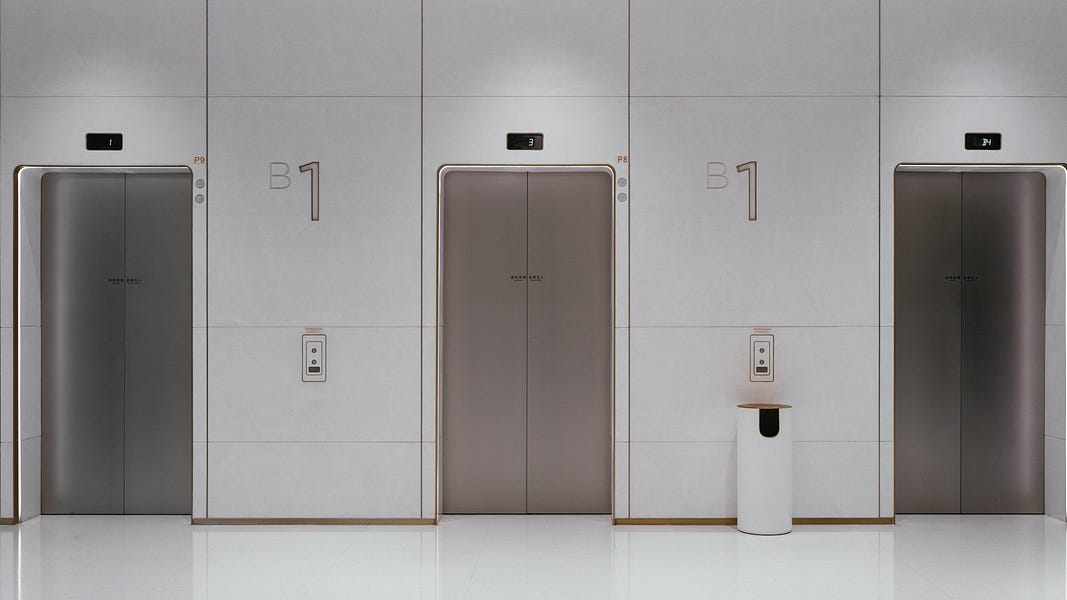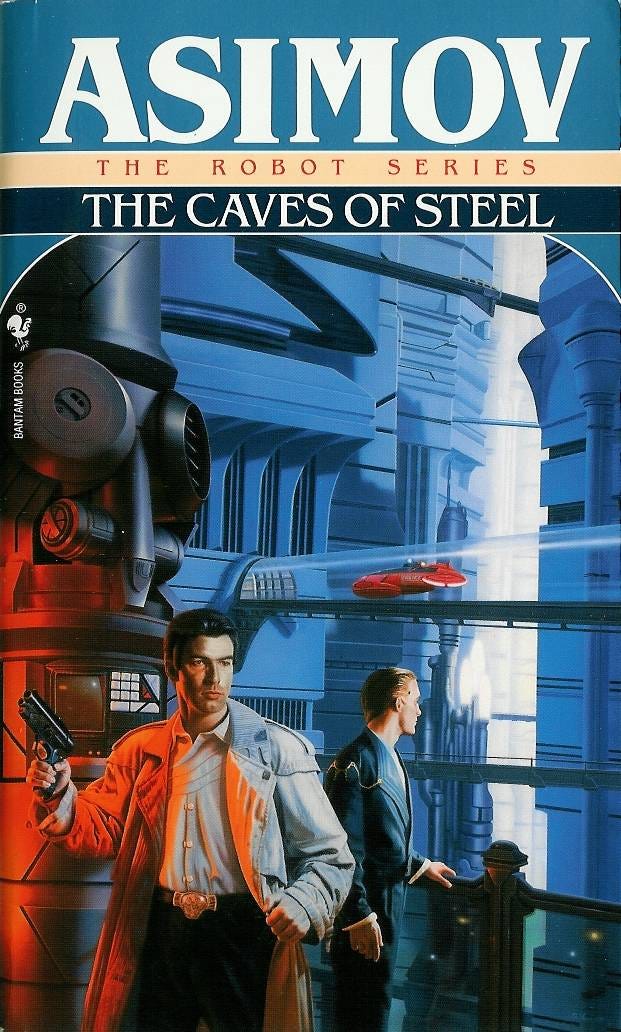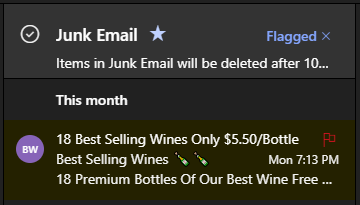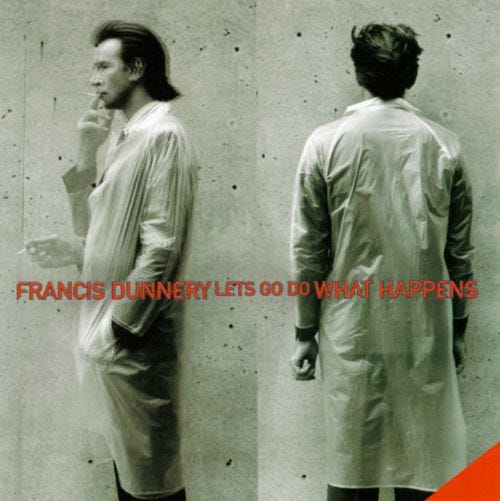Category: Longform
You are viewing all posts from this category, beginning with the most recent.
A short horse tale | Short Fiction
MERRY FREAKIN’ CHRISTMAS, that’s craaaaaaaazy lookin’! Photo by Mikael Kristenson on Unsplash
One day long ago, a horse I was fond of came to me and bit my arm, breaking the skin.
As blood seeped from the wound I asked, “Why did you bite me.”
The stallion shook its proud head, stamped its powerful hooves, and whinnied, “Because I can, small human.”
“That is sad,” I replied.
“Picking yourself up by your own bootstraps” is stupid.
If this were even remotely possible, people would be flying off into space willy nilly. I think, I’m not a scientist. Photo by Nik on UnsplashWhat even are bootstraps? I’ll keep this brief. I’m particularly fond of this tidy explainer from Etymonline, a language etymology website:
How to use an elevator
" “>
A bank of elevators in the lobby of a skyscraper. Photo by Edwin Chen on UnsplashIt happens all the time. You’re walking along, getting stuff done, and an elevator comes into the equation. Now what?
I desperately want a lightweight OLED Switch
" “>
Just make a bigger one, Nintendo.It was a mistake that when I finally bought a Switch, I got a Switch Lite. Sure, it’s a gorgeous indigo blue, but I’m old and the screen is too small. So, I bought an OLED Switch. It was also likely a mistake when instead of returning the Lite, I put it on a shelf and forgot about it. I’d made my new OLED Switch my main, so I’d just forgotten about its little brother.
Where the hell is the American Bidet Revolution!?
" “>
I’m going to guess that at least 12% of you will be reading this on a toilet.
Nothing makes people feel at ease more than a very public discussion about pooping… Right?
Fortunately for you, I’m not making this a video or podcast, so you can read it anywhere. Even on a public toilet.
Let’s talk about conservation of energy. Now, I know that’s a scientific principle of something, but I’m no scientist so I’m not sure how accurate I’ll be, but this whole thing seems rather obvious to me. So much so, that I’m more than a little shocked no rabid capitalistas have leapt on the Bidet Bandwagon. And no, that bandwagon doesn’t sound very fun, but we’ll get to the bidet in a moment. First, we need to talk about toilet paper.
Infographic: The U.S. Leads the World in Toilet Paper Consumption
The Statista "Chart of the Day" currently focuses on two sectors: "Media and Technology", updated daily and featuring…www.statista.comThe Average American Uses 3 Rolls of Toilet Paper Each Week-And It's Devastating Forests
A new report on paper use says Americans are flushing away Canadian forests. Stand.earth and the National Resources…fortune.comWe Americans appear to go through about 141 rolls a year per person, at least according to Statista (See link above. -Ed.) Note that the rolls they are referencing are 90 grams (Siri says that’s 3.7 ounces), which I’m assuming are the classic-style rolls. Of course, almost everyone buys the jumbo and mega roll packs, so some basic maths will need to be performed…
Oh, never mind! Some nice person over at The Federalist, a right-wing eTabloid, took care of that for us. Go ahead. Read it. It won’t bite, but you might come away with a spike in your depression for a few days.
No, Each American Doesn't Use Three Rolls Of Toilet Paper Per Week
Fortune magazine's toilet paper numbers are full of crap. If we do math with the actual weight of a roll of toilet…thefederalist.comYou see, he says the maths are all wrong because we aren’t buying those dinky little old-timey toilet paper rolls. No, we are, as I just mentioned, buying those large rolls so… We’re not really using a 141 rolls a year, per American, mind you, we’re really using 56.
And that’s a whole lot less than 141… Right?
I guess the simple fact that slipped past this stable genius is that the heavier rolls are longer and have more material in them. You know, all those plys, they come from somewhere, dude. Go to Costco, Walmart, Sam’s Club, or any big box store that carries toilet paper, and you’ll find stacks of “Double” and “Triple” roll options.
So, Kyle, let’s talk this out. I think you could be right that most Americans use about one roll a week, but you know, those rolls are double and triple that basic roll, so its still approximately THREE ROLLS A WEEK. The fact that there are double and triple roll products explains the 2.7 rolls a week that the study actually cites, the number “3” being rounded for clarity and because rounding numbers isn’t typically considered a criminal act.
Science is hard. I get it.
Also, I should note that the Fortune piece above was published in 2019, before the pandemic. I doubt that Americans used more toilet paper during lockdowns, but we sure as hell bought a lot more at one time. Gotta love those hoarders and preppers. Of course, you can only hoard essentials if you have the resources to do so.
Oh… Kyle… Wow, man. I’m so sorry…Damn, that’s lot of toilet paper
Let’s get down to brass tacks. Nobody likes wiping. It’s gross and irritating and the paper can fall apart, and don’t get me started about criminally thin industrial-grade TP in public, retail and commercial bathrooms. It gets stuck to shoes, falls out of trash cans, doesn’t evacuate “the crevasse”, and periodically difficult to locate for purchase. Yeah, everybody poops, but I’m quite sure most of us don’t like it. It may be biological process necessary for the proper operation of the human body, but it’s a pain in the ass, literally and figuratively.
Must we complicate it? Turns out we kind of need to, and yes, there is a Wikipedia entry on “Anal Hygiene.”
I’d like to take a moment to point out the atrocious grammar in the following Wikipedia page summary that makes it sound like hygienic practices are performed by one group of people on another group of people’s anuses…like a service? I’m not the Grammar Gestapo, and I’m not perfect, but that can clearly give people the wrong impression about something rather private. I’m just sayin’…Anal hygiene - Wikipedia
Anal hygiene or anal cleansing refers to hygienic practices that are performed on a person's anus, usually shortly…en.wikipedia.orgThere’s no point in denying it. We all know the fix.
Easy peasy, lemon squeezy…Let me ask you a question…
Do you thoroughly wash your privates in the bath?
So, functionally how different is washing them in one go on the toilet from getting in the shower to do the same thing? Short Answer: It’s not.
No. Nobody expects everyone to install a bidet. I’d be shocked if anyone in government ever suggested that installations be mandatory. It’s not some kind of weird poop-specific conspiracy, either. It’s just a little gadget you can add to your existing toilet and use privately with nobody knowing… except you, and I bet you secretly prefer it.
Prove me wrong ;)
An Open Letter to Blue Sky's Chris Wedge
" “>
Hey look! It’s you!! Chris Wedge!!! Nice pic. Great movie.
Dear Chris,
I heard the news. I’m sorry I didn’t write sooner. Things have been a tad crazy of late, what with the pandemic and gun violence and political division and illegal wars and whatnot. I started writing this before the war and Uvalde, but I felt it was important to acknowledge these facts of life and death we are facing before I launch into this escapist fever dream. Anyway…
Disney can be quite the pain in the ass these days, what with all the acquisitions and late-stage Capitalism and all. I recently read the Paste piece, An Oral History of Scrat Tales: The Death and Legacy of Blue Sky Studios, and I feel for you and your peeps. For the record, I don’t think it was a mistake to be hopeful that Disney would act to protect contemporaries of the modern animation industry. You know, because Disney is one of the most prolific animation studios ever.
Such presence gives you the impression that they might commiserate. In retrospect, they did end up protecting a legacy, namely their own … by engaging in predatory catch-and-kill just to shut you down and absorb your valuable intellectual property and talent. But hey! Live and learn, right? We just have to process and integrate the setbacks and and keep pushing forward while keeping a sharp eye on our past, as it informs us of potential futures and how to avoid them. (If that’s what “we” want, that is.)
And there’s nothing Disney can do to erase Blue Sky’s legacy as one of the few smaller studios that could offer the big players a challenge at the box office, to be sure alongside Chris Meledandri’s Illumination. Thirty-five years, thirteen theatrical films, more than $5 billion in revenues, and two Oscar nominations, Blue Sky was no joke. Dude! You yourself won a freaking Oscar for Bunny back in 1998 only to release Ice Age two years later. And I don’t care what anyone says, but 2005’s Robots is a just a masterpiece. One of the truly underrated greats, in the same vein as The Road to El Dorado, The Iron Giant (Vin Diesel’s best role by far), or Disney’s own The Emperor’s New Groove, to name a few.
You, sir, are a force in the world of animation.
But, here we are. It’s 2022 and it has become clear that being a force for anything offers no friction to Disney’s ambitions. If they want to take on or end something, they can simply buy it. It’s like Disney went to the park with its ball, had a great time with everyone else while doing their damnedest to ignore you, and when he took his ball to go home, took your tricycle for good measure. And it’s not like the pandemic has been ‘helpful.’ I wouldn’t be shocked in the slightest to learn that aspects of Disney’s decision to close Blue Sky was to let them shunt more cash into their cash strapped amusement park division and fretting over content for their then upcoming Disney+ streaming service.
Looks like someone needs a new tricycle…
So, this is a pitch… of sorts. But it’s not a pitch for me. I’m simply offering the concept. I have no skills aside from stringing some vaguely comprehensible words together in sequence, but I do have an imagination. No, it’s a pitch for you.
Animate books.
Now, I’m not talking about the atrocious adaptations (not ADAPTIONS, people! A-dap-TAY-shuns, for cryin’ out loud) that plague our cinematic past, or even the really good ones, for that matter. Regardless of the quality, or lack thereof, these adaptations necessarily strip out loads of context, interactions and impressions, additional plot lines, and almost everything else to focus on the core story because, you know… two hours.
So, as insane as it sounds, what if you don’t do that. Instead, adapt the book as closely to the written work as possible. Take the dialog wholesale. Design the scenes to appear as described in the pages. In other words, use the book as the script, stage direction and all. Make each page fly out of the book and into a tangible world where the rules make sense because you know the story in static form.
A few more suggestions:
- Don’t change anything unless you have to for technical reasons. If the book is worthy to adapt, why would you change anything that wasn’t already constrained by the animation process, and we both know that animation offers no constraints. Period. We can do anything in animation.
- Don’t modify the plot, motivation or conflict so “modern” audiences can “relate” to it better. Again, if we love the tale, what benefit comes from modifying a major part of what made it resonate?
- Any character description should be taken as canon, everything else is fair game. If the author doesn’t mention any particular aspect or aspects of a character, you can flesh them out how you like, but if something is clearly stated, it needs to be there. Taking a text description into a fully-realized visual world means a lot will need to be filled in. The book, after all, is for the theater of the mind, so some expanded development is almost assuredly required for most any book.
- Don’t feel stuck making a film. In fact, DON’T make a film. Make a series, and make it as long as it needs to be to fit everything from the book in. Some books will lend themselves well to adapting a chapter to an episode rather neatly, while others might need more creative solutions. Trust the viewers to watch as little or as much as they prefer, much like reading a book!
- Hire the best voice actors for the cast, not just the “best” celebrity stand-ins. Name one time someone told you that the only reason they went to see a film was because actor X, Y, or Z was in the cast and no other reason. The draw is the tale itself, not whatever A-lister is attached to it. Sure, it’s a force multiplier, but this shouldn’t be about massive, unlimited profits, but the artfulness of the work and how it reflects on our human existence or shows us parts of ourselves that might help us better understand us as living, thinking creatures drifting through space and time just hoping the ride is mostly nice along the way. I don’t doubt, however, that money will be made.
If I, as a complete nobody that brings nothing to the fore, were to opine on a first step, I’d say take it slow. I’d shoot for a few test scenes from a book of your choice. If I were to choose, I’d start with Isaac Asimov, preferably Caves of Steel, the first in his Robot series.
The description of Isaac Asimov’s “The Caves of Steel” taken from GoodReads.com — “A millennium into the future two advancements have altered the course of human history: the colonization of the galaxy and the creation of the positronic brain. Isaac Asimov’s Robot novels chronicle the unlikely partnership between a New York City detective and a humanoid robot who must learn to work together. Like most people left behind on an over-populated Earth, New York City police detective Elijah Baley had little love for either the arrogant Spacers or their robotic companions. But when a prominent Spacer is murdered under mysterious circumstances, Baley is ordered to the Outer Worlds to help track down the killer. The relationship between [Lije] and his Spacer superiors, who distrusted all Earthmen, was strained from the start. Then he learned that they had assigned him a partner: R. Daneel Olivaw. Worst of all was that the “R” stood for robot — and his positronic partner was made in the image and likeness of the murder victim!” The novel is one of Asimov’s many “proofs” that science fiction can be applied to any genre, not just its own, not that Asimov needed to prove anything to anyone :)Simply put, and apologies for being a tad brutal here, but nobody has given the idea of a 1:1 adaptation through the artistry and flexibility of animation a go before, and it’s not like you’ve got much else going on… I mean you’re exec’ing on some Puyo Puyo movie and some “Popeye” thing. That can hardly be taxing.
I kid… a little.
With the right property, the correct treatment, with solid massaging by a quality team that groks the rules, I think you’d have one killer app on your hands, and significant demand for more. But like I said before getting excited again, take it even slower.
Whip the first few chapters of Caves of Steel into storyboard form. Try blocking out some solutions for inner monologues and other “unfilmables”. Cobble out a few scenes, see how they work around the dialog. How much runtime can you get out of a chapter?
Of course, for a storied legend in your field, this would be a cake walk.
;P
Sincerely,
Tyler Knows Nothing
The Preamble of The U.S. Constitution | Shallow Thoughts
" “>
How do we define the United States of America? We call it a country, but that just means a plot of land with established borders. Land certainly tells stories, but those tales are woven over millennia, and definitions within that context just don’t scale down for the convenience of our human time-frame.
The first quote I think of in regards to the makeup of our government is that it is formed…
…of the people, by the people, and for the people…Sounds familiar, right? Well, it’s not from the US Constitution. The quote comes from Lincoln’s Gettysburg Address, and the idea had been discussed by others for centuries. That might disappoint you, if you didn’t know that until now, but we do have an actual Constitution. If you need a refresher, here’s the subject of today’s Shallow Thoughts, the Preamble:
See if you can find the correction in the Preamble. Surprisingly, there are lots of corrections in the Constitution, which raises a question. If this was accepted as the final draft for the establishment of an entire country, how many punctuation errors are there, say, in the 2nd Amendment?
We the People of the United States, in Order to form a more perfect Union, establish Justice, insure domestic Tranquility, provide for the common defence, promote the general Welfare, and secure the Blessings of Liberty to ourselves and our Posterity, do ordain and establish this Constitution for the United States of America.You see, Lincoln’s sentiment is squishy and unclear. It’s nice, but it is not a ratified legal document. Just because the president says it, doesn’t make it law, or even true. It’s an aspirational concept. The Preamble, on the other hand, is a lucid, if flowery, 10,000 ft. outline of the idea behind America. At the time the definition of “people” was limited to white folk, but that’s the thing about weasel language being used to establish important institutions. The words you choose could have an unintended outcome at some point in the future.
That point in time has been here since, at the very least, Reconstruction and “We the people” must now mean all humans. So-called “minorities” have been struggling for inclusion in the privileged caste since their feet first touched the shores of this ancient land, and while we’ve made progress over the course of a few hundred years, we keep getting dragged back by parties who are both inclined towards racial animosity and have amassed the resources necessary to control the direction of government. Those “resources” also include questionably warm bodies like almost the entire Republican party currently in office. Besides, much of the progress seen in minority populations is merely token, a bone if you will, to keep the boat from rocking too much.
Wading the shallows…
It might just be me, lord knows I never finished college (half a dozen times), but when your founding document starts with “We the people” and you use the formalized structure of organized society outlined in said document to exclude actual human people from deriving those benefits or achieving those aspirations while simultaneously granting favored whites free reign to commit crimes against minority bodies, that it specifically means we haven’t achieved the very first, most basic mandate of our Constitution in nearly 250 years?
Kinda feels like we’ve all been getting gaslit for the last 400 years.
Or maybe, just maybe*, we had a Civil War over the enslavement of human beings for purposes of building the nation we stole from the natives who had been establishing societies for thousands upon thousands of years where the slavers lost, but because of government flaccidity on the matter, didn’t bother actually enforcing equality for all those supposedly now free, new Americans and caved on States Rights, so that racist states could continue to oppress its citizens, but now with a veneer of sovereign legitimacy.
Who knew we’d develop such deep, violent rifts between races in a country where non-white humans have been chewed up and spat out, all to appease fragile white egos, but what do I know…
PS: YouTube is something of a cesspool. Despite this, I really love it. Well, I love the creators. Most of my content consumption is on YouTube, as I’ve found many, many creators who love what they do and put in the work. And yet, much of YouTube is filled with crap. Sure, it might be a nice place to keep your family videos of your meals and pets or terribly racist screeds and calls for race wars, but all the extra bandwidth, in storage, over the network, and in your hardware/software solutions, consume a constant flow of electricity to maintain.
PPS: Meanwhile, our Earth-bound resources, which have a limited lifespan, are being burnt to spin the turbines that delivers power to the infrastructure, systems, suppliers, and services that reliably energize global capitalism efforts, but is used as a tool of oppression for the terminally lower class minorities. Don’t pay your bill, you get cut off, so you have to work, but you can only take a job that pays minimum wage, which isn’t a living wage, so you need to take another job or two, just to keep the water and lights on and for trash to get picked up on occasion. Oh, and don’t forget rent…
PPPS: As the non-1% are dragged along with hypercapitalism’s reckless, futile desire to chase the mythological beast of unlimited growth, it seems we must make ourselves content with just waiting to see what happens. Maybe we should rewrite the Preamble:
We the selfish, recognized white People of the United States, in Order to form a more perfect Union in our image, establish Justice for some, insure domestic Tranquility for the few, provide for the common defence of the powerful, promote the general Welfare of private business, and secure the Blessings of Liberty to just us and our Posterity, do ordain and establish this Constitution for the United States of America until we think it’s no longer worth maintaining and drop the pretense.And if that’s what’s going to happen, then the death of planet Earth will come sooner, at least for us, than I think most of us would hope. The wealthy and their sycophants will just build themselves bunkers or whatnot so they’ll live, as will their descendants, and what do you think their parents are going to teach them about the world?
What, indeed.
* There’s no question that the Civil War happened due to disagreements over slavery. I’m just being sarcastic. The enslavement of human beings should never, ever be something that can be disagreed with. It’s criminal. Period.
Outlook Junkmail Arrives Flagged ... By Spammers
" “>
I’ve been having a problem lately. It’s not an enormous issue, but it bothers me. As you have likely already gleaned, I am receiving junk mail in my Outlook.com account which is already flagged, like so:
An example of a pre-flagged spam message.I don’t think most people have noticed it for a couple reasons:
- I don’t think a lot of users flag their emails unless they are using the desktop version.
- Flagging is a visual cue that has only recently started to become a component of organization tools, i.e., Microsoft To Do.
Outlook.com, however, is an interesting beast; at once the best damned email client on the planet while being rather terrible at handling spam… sorta. I’ll get to the best part in a sec, but Google’s Gmail is far better at filtering spam.
The online version of Outlook was originally designed to not only replace HoTMaiL (if you’ve never noticed, the capitalization is deliberate), but to compete with the growing number of players in the nascent Webmail arena. Microsoft had fumbled in the early days of the internet had to catch up to the growth of services like Google’s Gmail, Yahoo!’s RocketMail, and offerings from AOL (“You’ve Got Mail!”) and Compuserve.
In 2012, Microsoft replaced Microsoft Live Hotmail with Outlook.com, and offered the Beta version to the general public to try. I joined that beta, and added an Outlook.com address to my seldom-used Hotmail account. I was immediately impressed with the new interface, and have mostly enjoyed using it over Gmail for years now. The current version of Outlook.com is extremely complete, and I can understand why casual users might find it confusing. If, however, you are experienced with using the Outlook desktop application, you won’t have too steep a learning curve.
But it’s generally never about the features that work when I post. In this case, it’s about spam getting flagged automatically. This is a real problem now, and I’ll explain why, but let’s first take a look at what another Windows user posted to Microsoft’s community support forums:
This is one of the only posts I could find about this issue and the answers were… unhelpful?
As you likely noted in the image at the top of this post, I’ve been having the same problem. Some emails will come set to Urgent and Flagged. Flagging a message in any version of Outlook is a visual indicator that you, as the user, add to show importance or act as a reminder. As I mentioned before, the Flag has traditionally been a user-only function.
That changed after Microsoft acquired Wunderlist from German developer 6Wunderkinder GmbH.
That’s not to suggest that Redmond’s acquisition had a lot to do with the issues I and other(s?) face, but it’s how I discovered the issue in the first place. I used Wunderlist as an all around replacement for Evernote and a checklist app. It was very good at that, but MS decided they needed an app like that, so they bought the company and finally phased out Wunderlist on May 6th of this year. Now we have To Do, a fine app that leans even more into the task management space.
Unfortunately, one of its neat little productivity features is that it has an auto-generated listicle with all of your Flagged messages. This would really be great if it worked as intended, showing the items you flagged so you can be reminded to handle them. Instead, upon initial inspection I was treated to a cavalcade of Coronavirus cures, manhood pills, offers of millions of dollars from some dead prince in Idaho or Saskatchewan or Kazakhstan.
So, that’s about it. There’s no real solution that I’ve sussed out just yet, nor have I seen very many questions posted about it. Like I said, I don’t think a lot of people are going to experience what I believe is an edge case. This just doesn’t yet happen to many users.
We’ll see where things go from here.
PS: This is a repost from my blog, which I’ve been having issues with. I’m now in the process of making a decision about where my bloggings will reside. My options are to restore WordPress on my most atrocious host, go back to PostHaven (which I adore but has posting and formatting limitations), or devote my efforts to Medium (which has an in-built audience.) I have yet to choose.
PPS: Part of the problem, and it’s a large part, is the depression I’ve been “managing” over the years. The pandemic hasn’t helped, as you can well imagine, and the current political climate on Earth is… er, suboptimal, to say the least. Shit like this makes the future unclear for the billions of regular peeps around the world who just want to live a life. And the leadership necessary to guide us out of this dark place we’ve allowed ourselves to get lost in seems to be down at the pub doing lines of coke and kicking hobos for fun, so few peeps have hope for a brighter, less self-destructive future.
PPPS: You don’t have to love everyone, just don’t go around killing them. They randomly appeared on Earth just like everyone else. We don’t get to choose who we are or where or to whom we are born, whether it is the chaotic, unintelligent course of events of a vast unknown cosmos or the will of some god(s). Is it not, then, logical to presume, until evidence to the contrary of course, that none of us are inherently superior to anyone else? Life, for now, is just the luck of the draw, and maybe 3% of peeps win the lottery. The name of the game has always been extraction…
PPPPS: Listen to Dylan, then extrapolate from then until now and what’s happening. Its ugly and we’re in deep, deep trouble if we don’t do something fast. What those fixes are, I have no idea.
Francis Dunnery’s Let’s Go Do What Happens | Album Stories
" “>
Everyone calls him Frank. Let’s Go Do What Happens was released in 1998.I’m quite sure that it was early Fall in Vermont; leaf turning season. It drew the leaf peepers and they brought their money. We didn’t turn in those circles, or any circles for that matter. We spent time at home or at school or with the baby or at various jobs. She worked at the Vermont State Department of Corrections for a time. I worked at the nearby IBM plant for a spell. I attempted another go at college. I’d like to think we failed each other.
Have a listen to the album while reading this piece.The radio station that had to be on in the car at the time was The Point FM, de rigueur for any self-respecting AAA aficionado. Where else was one to catch up with the latest singles from Big Head Todd & The Monsters, R.E.M. or Dave Matthews Band, note the dates for a coming Phish show, or score a tip on hemp floor mats or locally roasted coffee (yes, that Green Mountain Coffee.)
I honestly don’t recall the track from this album I heard on the radio that caused me to suddenly know I had to own it, but it could have been any of them. Normally, I have at the very least, a sense of which track, but not this one. All I know is I got in the car, drove down to the Sam Goody (I think, might have been a Wherehouse) off the 189 at Shelburne, and bought the cassette. I slapped it into the tape deck and listened to it all the way home.
Thank you, Auto Reverse.
Little did I know at the time, but Francis Dunnery was to become a very important figure in my one-person chapter of Tyler’s Music Appreciation Society. In 1998, however, I didn’t place as much importance on music as I would later in life, specifically in regard to my progressive self-education. Hell, at the time I hadn’t yet come to grips with The Blues and still had a stunted understanding of Jazz.
I knew at the time, however, that Dunnery spoke to me with his lyrical content, compositional style, sound, and his distinctive vocal quality. I’ve come to understand this as Storyteller Syndrome; my principle thesis on progressive rock. In a nutshell, that one thing that sets progressive apart from its core genre is story telling. Most people think that “Prog Rock” is epic long tracks with soaring guitars, complex beats, and tales of space ships and wizards. I propose that couldn’t be further from the truth.
Rocks songs are about love and loss. Prog rock songs are about stories. — Tyler Regas, 2020Even the most epic prog rock band of all time forever and ever, known to mortals as Rush, moved away from 15 minute long tracks and tales about hobbits and dragons to more socially conscious fare packaged into tighter, radio-friendly formats. In 1973, Yes released Tales from Topographic Oceans, four songs stretched over two albums, and completely radio-hostile. Just a decade later, and Yes would have a huge radio hit with Owner of a Lonely Heart. I don’t think anyone would argue that Yes should be disavowed. That would be absurd.
Now, I won’t try to suggest that any song that tells a story is progressive. No. It’s more than that. It has to be something new but retain principle elements of rock music, to take that music in a new direction, and evoke a reaction in the listener, one that provokes new avenues of thought or introspection, through storytelling or other narrative structures. This can even be done instrumentally. Just take a listen to any of Simon Phillips’ Protocol albums, Plini, or Arch Echo.
Tell me that Biplane to Bermuda doesn’t paint an interesting picture…Lush, hard prog rock instrumental soundscapes.If you love Animals As Leaders but miss recognizable song structure.In a way, we get to witness Dunnery’s trajectory through the late stages of the Golden Age of Progressive through his stint as frontman for influential UK band It Bites and into his solo albums. Not well known outside of the UK, It Bites is what I personally recognize as the last of the original progressive rocks bands of the golden era of prog. Most notable of his solo efforts is 2016’s Vampires release on Band Camp where he makes what he had originally intended for certain It Bites tracks quite clear, if you know what I mean. They have since come to terms.
The late 90’s, however, were different for me. Not having the benefit of hindsight, we carried on with whatever priorities we had at the time, and that was taking care of Leah and making sure we could pay the bills. The writing work had started to take off and the local clients we consulted for were stable. We only had the issues facing us at the time and had no idea that, in just a few years the Twin Towers would fall and seven years after that America would experience the biggest financial collapse since The Great Depression.
It seems that time really doesn’t have an impact. We’re still facing disaster, only it’s different and worse and our fault since we let that buffoon Trump get elected in the first place, but that’s beside the point. These days there’s plenty to be concerned about and for. We don’t know what’s going to be coming around the next corner, and it seems like we come to a new one several times a day. Even as we turn into 2021, we’re still exhausted by the chaos of it all, everything a question mark.
Back then, however, I just enjoyed listening to the music. Not that I knew at the time, but I had that luxury. We all did. I think we all can again, at least for a few moments.
Just start up the album. It’s at the top of the page in case you forgot. Sit back in a comfortable chair and just listen.
Think about the chord progression.Think about the beat.The rhythm.Tonality.Think about the lyrics, the story being told. Don’t worry about understanding it all just yet. Instead, let yourself sink into the music and just enjoy it, and nothing else, for a track or two. Do this once a day for two weeks.
Doctor’s orders.*
* I am not a doctor.
The Nothing | Short Fiction
" “>
The stairwell spirals down into the darkness. Well, not spiral, really, but there is no term that describes a rectangular shaped stairwell in a multi-story building. It didn’t matter, though. There was already a name for it. It was called The Nothing, and it had been named a few generations back, long before I was born. I come to stare into The Nothing quite often. There isn’t much else to do and it wasn’t forbidden. In fact, the Elders encouraged it, likely to instill a sense of dread. People fear the dark. It’s not that it’s darkness, but that you don’t know what could be hiding inside of it. After all, there isn’t anything threatening about an absence of light.Back in “The Day”, people would venture down into The Nothing to see how far they could get. At some point they decided that it would be smart to remove the doors so that the light could shine into The Nothing, at least until it couldn’t. Few people had been down to the Last Door, but I went at least once or twice a month. There was a thrill that ran through me like a shiver as I would look down at the Last Door and the impenetrable darkness just beyond. Our Elders tell tales of the Doormen who had taken the Last Door off of it’s hinges.
The final pin falls, the Doormen laugh.
Ping, ping, ping, then into The Nothing.
Then it makes no sound. Did it stop?
The Doormen reset their steely resolve.One step, two. The Nothing remains silent.
Two step, three. Doorman Pellis vanishes.
Doorman Stev reaches out to grab nothing.
The beginning of The Nothing is found.Do not venture past the Last Door.
The 28th is the End of Our World.The Elders made it sound ominous and scary, but nobody knew what was beyond The Nothing. There was nothing to indicate what was different. Every once in a while, some idiot would head down there, drunk on Roofberry Wine, and his friends would dare them. A few times it was proven that touching the 3rd step down from the 28th floor caused people to literally vanish. They didn’t fall. They’d just blink out. I wasn’t eager to discover the truth of it, so I stayed on the 29th, looking down. That was satisfaction enough for me.










